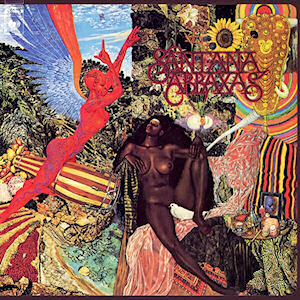
Abraxas is the second studio album by Latin rock band Santana. It was released on September 23, 1970 by Columbia Records and became the band's first album to reach number one in the United States.

Santana is the debut studio album by American Latin rock band Santana. It was released on August 22, 1969. Over half of the album's length is composed of instrumental music, recorded by what was originally a purely free-form jam band. At the suggestion of manager Bill Graham, the band took to writing more conventional songs for more impact, but managed to retain the essence of improvisation in the music.

Santana is the third studio album by the American rock band Santana. The band's second self-titled album, it is often referred to as III or Santana III to distinguish it from the band's 1969 debut album. The album was also known as Man with an Outstretched Hand, after its album cover image. It was the third and last album by the Woodstock-era lineup, until their reunion on Santana IV in 2016. It was also considered by many to be the band's peak commercially and musically, as subsequent releases aimed towards more experimental jazz fusion and Latin music. The album also marked the addition of 17-year-old guitarist Neal Schon to the group.

Caravanserai is the fourth studio album by American rock band Santana, released on October 11, 1972. The album marked a period of transition for Santana as it was the band's last to feature several key early members, while shifting in a more instrumental, progressive jazz fusion direction. It sold in fewer quantities than the band's previous chart-topping albums, stalling at No. 8 on the Billboard LPs chart, but has been critically acclaimed.

Welcome is the fifth studio album by Santana, released in 1973. It followed the jazz-fusion formula that the preceding Caravanserai had inaugurated, but with an expanded and different lineup this time. Gregg Rolie had left the band along with Neal Schon to form Journey, and they were replaced by Tom Coster, Richard Kermode and Leon Thomas, along with guest John McLaughlin, who had collaborated with Carlos Santana on Love Devotion Surrender. Welcome also featured John Coltrane's widow, Alice, as a pianist on the album's opening track, "Going Home" and Flora Purim on vocals. This album was far more experimental than the first four albums, and Welcome did not produce any hit singles.
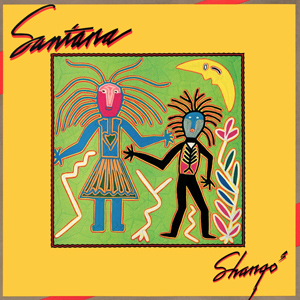
Shangó is the thirteenth studio album by Santana. The album reached #22 on the Billboard 200 album charts. The single "Hold On" from the album reached number 15 in the U.S. Billboard Hot 100 singles chart and number 17 on Billboard's Top Tracks chart. A second single from the album, "Nowhere to Run", peaked at number 66 on the Hot 100 chart and number thirteen on the Mainstream Rock chart and a third single reached number 34 in the Mainstream Rock chart.
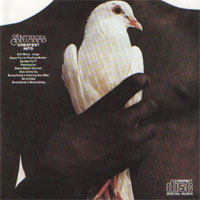
Santana's Greatest Hits is a 1974 compilation album by Santana. It offers highlights from the group's first three albums. It is the band's best-selling compilation album, selling over 7 million copies in the U.S.

Amigos is the seventh studio album by Santana released in 1976. It generated a minor U.S. hit single in "Let It Shine" and was the band's first album to hit the top ten on the Billboard charts since Caravanserai in 1972. In Europe, the song "Europa" was released as a single and became a top ten hit in several countries.
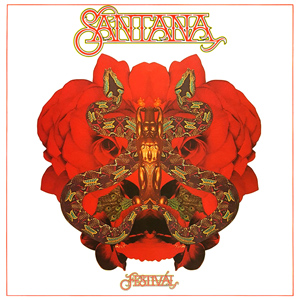
Festivál is the eighth studio album by Santana, released in January 1977. It peaked number twenty seven in the Billboard 200 chart and number twenty nine in the R&B Albums chart.
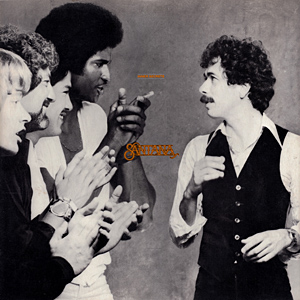
Inner Secrets is the tenth studio album by Santana. It was released in 1978 and, unlike the fusion of Latin, jazz, rock, blues and spirituality that characterized previous records, it was considered an album-oriented rock album.

Marathon is the eleventh studio album by Santana. This marked the beginning of the group's commercial slide, in spite of having the Top 40 hit "You Know That I Love You". Alex Ligertwood, who would sing with the group throughout the 1980s, joined the group for this album.

Zebop! is the 12th studio album by the American rock band Santana. The album had several releases, and various different color cover backgrounds, including pink and red. The album featured "Winning"; both the album and single were one of Santana's last top 40 hits until 1999 with their release of Supernatural.

Havana Moon is a solo album by Carlos Santana, released in 1983.

Freedom is the fifteenth studio album by Santana. By this recording, Santana had nine members, some of whom had returned after being with the band in previous versions. Freedom moved away from the more poppy sound of the previous album, Beyond Appearances and back to the band's original Latin rock. It failed, however, to revive Santana's commercial fortunes, reaching only ninety-five on the album chart.

Santana is an American rock band formed in San Francisco in 1966 by Mexican-born guitarist Carlos Santana. The band has undergone various recording and performing line-ups in its history, with Santana being the only consistent member. After signing with Columbia Records, the band's appearance at the Woodstock Festival in 1969 increased their profile and went on to record the commercially successful and critically-acclaimed albums Santana (1969), Abraxas (1970), and Santana III (1971). These were recorded by the group's "classic" line-up, featuring Gregg Rolie, Michael Carabello, Michael Shrieve, David Brown, and José "Chepito" Areas. Hit songs of this period include "Evil Ways", "Black Magic Woman", "Oye Como Va", and the instrumental "Samba Pa Ti".

The Essential Santana is a compilation album by Santana, released on 22 October 2002. The collection is part of a series of Essential sets released by Columbia Records.
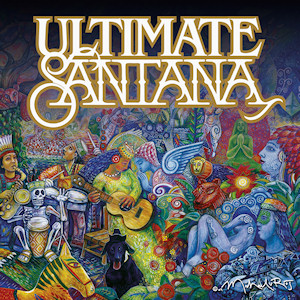
Ultimate Santana is a compilation by rock band Santana, combining hits from recent albums Supernatural, Shaman and All That I Am with early classics. Amongst the 18 tracks there are three new recordings. This album was made possible when Sony Music Entertainment merged with BMG to form Sony BMG.

Santana IV is the twenty-fourth studio album by American rock band Santana, released in April 2016.


















